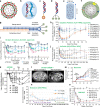Therapeutic siRNA: state of the art
- PMID: 32561705
- PMCID: PMC7305320
- DOI: 10.1038/s41392-020-0207-x
Therapeutic siRNA: state of the art
Abstract
RNA interference (RNAi) is an ancient biological mechanism used to defend against external invasion. It theoretically can silence any disease-related genes in a sequence-specific manner, making small interfering RNA (siRNA) a promising therapeutic modality. After a two-decade journey from its discovery, two approvals of siRNA therapeutics, ONPATTRO® (patisiran) and GIVLAARI™ (givosiran), have been achieved by Alnylam Pharmaceuticals. Reviewing the long-term pharmaceutical history of human beings, siRNA therapy currently has set up an extraordinary milestone, as it has already changed and will continue to change the treatment and management of human diseases. It can be administered quarterly, even twice-yearly, to achieve therapeutic effects, which is not the case for small molecules and antibodies. The drug development process was extremely hard, aiming to surmount complex obstacles, such as how to efficiently and safely deliver siRNAs to desired tissues and cells and how to enhance the performance of siRNAs with respect to their activity, stability, specificity and potential off-target effects. In this review, the evolution of siRNA chemical modifications and their biomedical performance are comprehensively reviewed. All clinically explored and commercialized siRNA delivery platforms, including the GalNAc (N-acetylgalactosamine)-siRNA conjugate, and their fundamental design principles are thoroughly discussed. The latest progress in siRNA therapeutic development is also summarized. This review provides a comprehensive view and roadmap for general readers working in the field.
Conflict of interest statement
The authors declare no competing interests.
Figures







References
-
- Anguela XM, High KA. Entering the modern era of gene therapy. Annu Rev. Med. 2019;70:273–288. - PubMed
-
- Weng Y, et al. RNAi therapeutic and its innovative biotechnological evolution. Biotechnol. Adv. 2019;37:801–825. - PubMed
-
- Weng Y, et al. The challenge and prospect of mRNA therapeutics landscape. Biotechnol. Adv. 2020;40:107534. - PubMed
-
- Setten RL, Rossi JJ, Han SP. The current state and future directions of RNAi-based therapeutics. Nat. Rev. Drug Discov. 2019;18:421–446. - PubMed
Publication types
MeSH terms
Substances
LinkOut - more resources
Full Text Sources
Other Literature Sources
Medical

